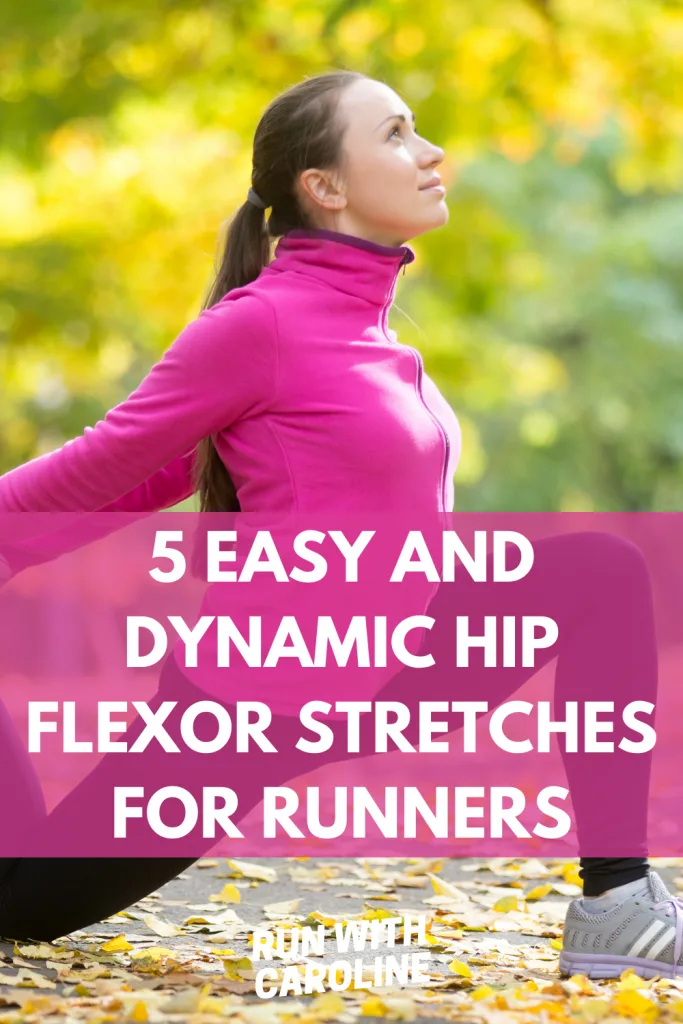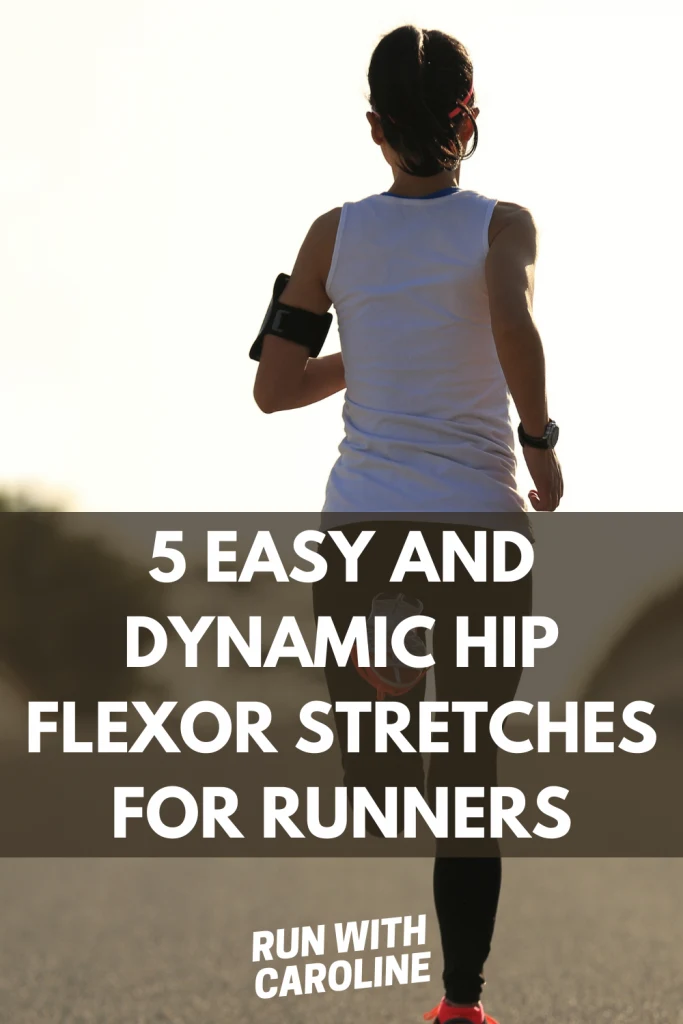Your hip flexors are the most important muscles in your body to keep you running strong.
Hip flexors maintain mobility, stability and strength of other muscles. As such, they are key supporting muscles.
For runners, your hip flexors are the main muscles to stretch and strengthen to avoid common running injuries.
When your hip flexors become tight, it’s important you include hip flexor stretches for runners like the ones in this guide in your routine.
In this guide we’ll explore:
- What are the hip flexors?
- Why is it important to have strong hip flexors when running?
- What are the causes of tight hip flexors?
- What are the signs and symptoms of tight hip flexors?
- How to strengthen your hip flexors
- How to stretch your hip flexors
- 5 dynamic hip flexor stretches for runners + how to do them
Ready?
Let’s go!

What are the hip flexors?
Your hip flexors are a group of muscles close to the top of your thighs. They play an important role when it comes to moving your lower body.
Hip flexors help to contract and pull the thigh towards the torso, allowing you to bring your knee towards your chest as you run.
On a more day to day level, your hip flexors allow you to:
- Walk
- Kick
- Bend
- Swivel your hips
Related: 3 quick and easy habits for injury free running
Why is it important to have strong hip flexors when running?
Strong hip flexors help to improve running economy and performance and reduce the risk of common running injuries.
According to a 2005 study, an increase in hip flexion strength can help to improve sprint and agility performance for physically active, untrained individuals.
It’s also important to strengthen your hips as a runner because if your hips are not strong, or become weak, you increase the risk of improper posture and alignment of the hips.
Poor posture and misalignment of the hips will increase the risk of injuries like IT band syndrome and runner’s knee.
Here are some other common side affects of weak hip flexors:
- Lower back pain
- Weak abdominal muscles
- Weak hamstrings
- Tightness in the lower back
- Tightness in the hip flexors
The bottom line? When you strengthen your hips, you will improve running performance and will minimise the chances of common running injuries occurring.
Related: How to prevent knee pain when running

Related: What muscles does running work? 5 ways to prevent common running injuries
What are the causes of tight hip flexors?
The main cause of tight hip flexors is linked with leading a sedentary lifestyle.
Car travel and sitting behind a desk all day cause your hip flexors to become overused and under-stretched.
The fact is, the more time you spend in a seated position, the more time your hip flexors are kept in a shortened position, which in turn makes them tight.
If you’re a runner, tight hip flexors equals problems with your running posture and running mechanics.
The tighter your hip flexors, the more your pelvis tilts back and the more likely you are to lean forward (arch your back and stick your bum out) when you run.
Over time, poor posture like this not only leads to injury, but can seriously impact your running efficiency and performance.
The bottom line? Tight hip flexors are linked to a range of common problems, including lower back pain, tight hamstrings, knee pain, shin splints and even IT band syndrome.
So it’s important you strengthen and stretch them on a regular basis.
Related: Hip pain after running: 8 causes + how to fix it
What are the signs and symptoms of tight hip flexors?
Here are some common signs and symptoms of tight hip flexors that you should look out for:
- A sharp or sudden pain in the hip, pelvis or groin area
- Tenderness or cramping along the upper leg
- Swelling or bruising on the hips or outer thigh
- Pain in an adjacent muscle group, like your glutes or core
- Muscle spasms in the thighs or hips
- Reduced mobility when you walk, run or jump
- Limping
- Stiffness or tightness when you’ve been sat down for too long.
- Lower back pain
- Tightness around the neck
- Difficulty sitting up
Related: 5 important things to do once you have a running injury
How to strengthen your hip flexors
Strengthening the hip muscles is very important.
To help you run more efficiently it’s important to include hip strengthening exercises as well as stretches in your running routine.
In fact, strength training, stretching and mobility work all work together to strengthen and loosen up your hip flexors.
Here are some exercises to strengthen your hip flexors:
- Side leg raises
- Bird dog
- Reverse lunge with knee lift
- Single leg bridge
- Donkey kickbacks
Related: 9 quick and easy dynamic warm up stretches to before a run
How to stretch your hip flexors
You may be wondering: “How do you loosen tight hip flexors?”
Well, as well as strength work, it’s important you stretch your hip flexors to help release tension, open up your hips and keep them loose in the long term.
The easiest way to do this is by adding the below 5 dynamic hip flexor stretches for runners into your training plan.
You can either do these stretches after a run as part of a cool down, at the gym after a strength training session, or from the comfort of your own home.
If you feel pain at any point while doing the stretch, stop the stretch. You should feel some tension but not pain.
Related: 7 glute strengthening exercises for runners

5 dynamic hip flexor stretches for runners
Here are 5 dynamic hip flexor stretches for runners.
#1 Low lunge stretch
The lunge stretch is probably one of my favourite and most satisfying hip flexor stretches for runners because it’s so simple and effective.
This stretch is great to stretch your quads and hips and it helps to relieve tension.
You can either do it before a run as part of a dynamic warm up, or after a run as part of your cool down.
- Stand with your feet together.
- Step forward with your right leg and extend your left behind you.
- Lower your left knee to the ground and keep your front knee directly above your ankle.
- You will feel the stretch in your left hip flexor.
- For a dynamic stretch, move your front knee and body in tiny circles. Repeat on the other leg.
- For a cool down stretch, hold the stretch for 30 seconds then repeat on the other leg.
#2 One-legged bridge lift
This stretch targets the glutes and lengthens and stretches the hip flexors.
It differs slightly from a traditional hip bridge in that your glutes are engaged a lot more to lift your hips.
Because you’re using one leg, you’re improving your balance and proprioception.
- Lie face up with your knees bent and feet flat on the floor. Rest your arms at your sides.
- Press into your heels and engage the glutes to lift hips.
- Transfer your weight onto your left leg and extend your right leg out for five breaths.
- Inhale as you lower your right leg to hover over the floor for five breaths. Exhale as you bring it back up.
- Repeat for 8 repetitions, then repeat on the opposite leg.
#3 Wide deep squat
This is probably the most well-known of the hip flexor stretches for runners.
A squat is a compound movement that targets various areas of the body, including your lower back, hamstrings and glutes.
Wide squats are ideal for the hip abductors. They increase mobility and open up that area.
- Stand with your feet slightly wider than your hips, toes pointing forwards so that your hips are open.
- Slowly bend your knees and lower your hips to the floor. Make sure you keep your back flat, keep your core engaged and your heels planted on the floor.
- Place your elbows inside of your thighs and gently press them out against the inside of your knees.
- Hold this pose for roughly 30 seconds then slowly release back to standing position.
#4 Standing wide leg forward bend
This is another one of my favourite hip flexor stretches for runners. I feel so good afterwards having done it.
The standing wide leg forward bend targets your hips and opens up your inner thighs and hamstrings.
- Stand with your feet three to four feet apart. Your heels should be a bit wider than your toes.
- Fold forward from the hips and place your hands on the floor. Remember to keep the soles of your feet flat on the floor and torso long.
- Hold this pose for roughly 30 seconds to one minute.
- If you feel flexible enough, feel free to lower onto your forearms for a deeper stretch.
#5 Reverse pigeon
There are various pigeon stretch exercises out there, but a lot of them require quite a bit of flexibility in order to do them successfully and without injuring yourself.
The reverse pigeon is a great exercise for first timers.
It targets the hip flexors by lengthening them and increases external range of motion in the hip socket.
- Lie on your back with your knees bent and your thighs parallel and hip distance apart.
- Cross your left ankle over your right thigh, making sure that your ankle bone clears your thigh.
- Actively flex your front foot by pulling your toes back.
- Gently pull your right knee in toward your chest.
- Thread your left arm through the triangle between your legs and clasp your hands around the back of your right leg.
- The goal is to avoid creating tension in your neck and shoulders as you open up your hips.
Related: How to get thicker thighs: 5 game-changing leg workouts
- 5 things I wish I’d known before returning to running - March 3, 2024
- Running 20 minutes a day: Benefits + how to start - January 27, 2024
- How to run your first 2 hour half marathon - January 16, 2024
